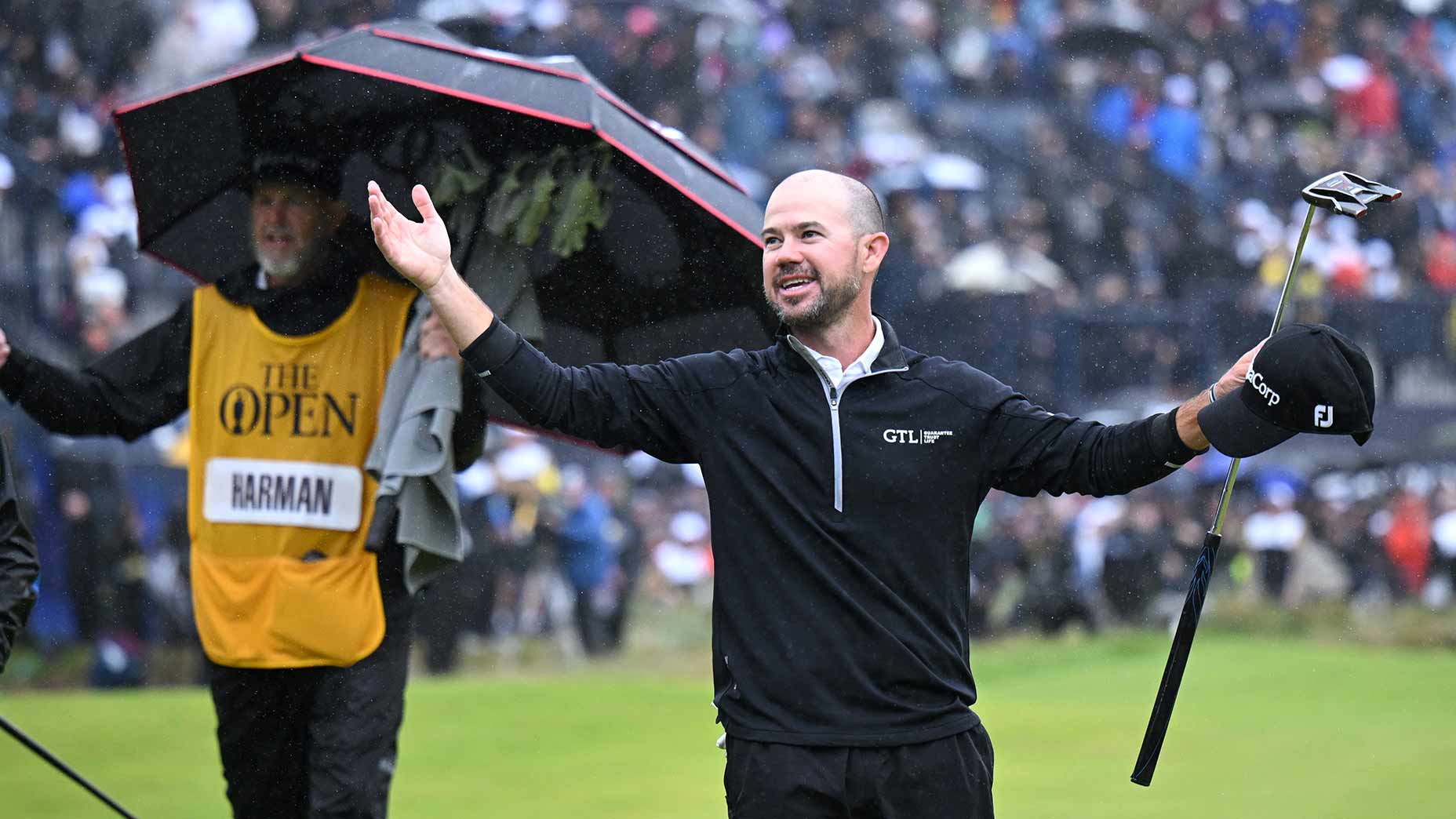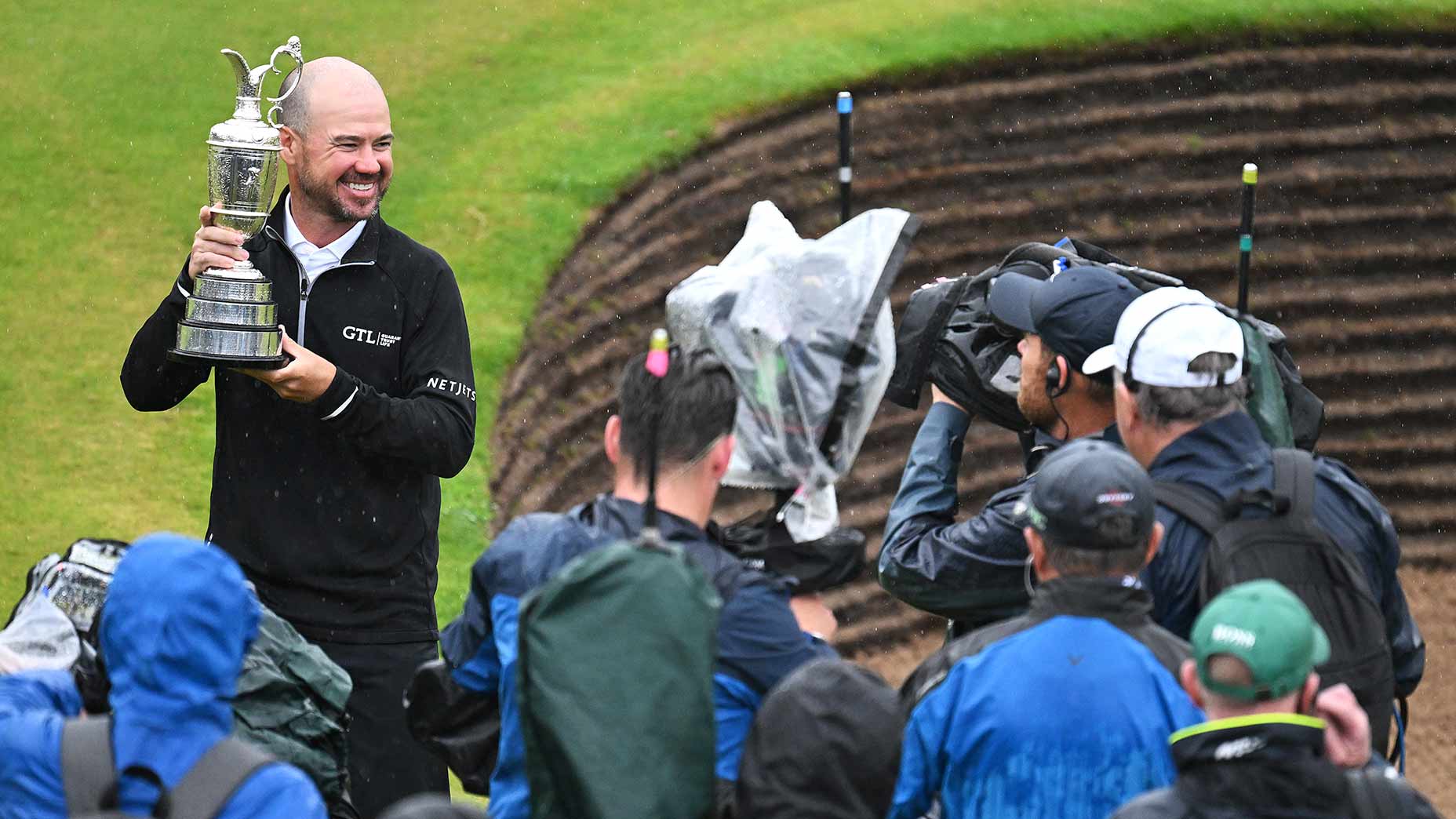
HOYLAKE, England — At 12:15 p.m. Sunday, two hours before Brian Harman teed off in what would be a life-changing round, lines were already long for grandstand seating at Royal Liverpool. Umbrellas were out, too. The Open Shop sold at least four different kinds of tournament-branded umbrellas this week: blue, navy blue, yellow and black. The galleries were dotted with them.
After surprisingly pleasant tournament conditions for most of the week, the weather turned on Sunday. The wind picked up and the rain was steady and sideways. Soggy walking trails turned muddy. Spectators walked with dirt splattered on their calves. The smart ones wore rain gear.
Yet no one looked unhappy.
At the other majors, these kind of conditions are miserable. But at The Open? They’re perfect. Something to embrace. The fans were in no rush, either. They were keen to settle in and find out if Harman — who at 36 had won just twice on the PGA Tour and not since the 2017 Wells Fargo Championship — was about to be remembered as Champion Golfer of the Year or, well, the next Van de Velde.
On Sunday, there was no in-between. It was the kind of round that would demand not birdies but brawn, of which Harman has an abundance.
When he teed off at 2:15 p.m. local time, Harman was at 12 under after rounds of 67-65-69 and five clear of his closest chaser. Yet, when the starter announced him, the applause was far from raucous. There were even some boos.
The crowds weren’t so much rooting against Harman as they were pulling for the players who were pursuing him.
Five back was Cameron Young, the 26-year-old reigning PGA Tour Rookie of the Year who had been the best tee-to-green player this week by a mile. He’s never won on the PGA Tour but finished solo second at last year’s Open at St. Andrews. Surely he wouldn’t want to come up oh-so close yet again.
Six back was Jon Rahm, the most accomplished, and dangerous, threat. He battled a cold putter early in the week but shot 63 on Saturday, taking advantage of an early morning tee time after a menacing weather forecast never came. He’d won four times this year, but nothing since his Masters victory.
And among the group at seven back: Tommy Fleetwood, who grew up 30 miles north of here and had literal thousands behind him. The crowds bellowed his name — “Go Tommy lad!” — and tried to will his ball into the hole. They sang his praises in Hoylake pubs and craved a Fleetwood major win so badly it hurt.
Spectators appeared more interested in Fleetwood (putting on the nearby 2nd green) or Rahm (in the 2nd fairway) than the somewhat unknown American. It wasn’t until Fleetwood finished and Rahm played into the green when a few more onlookers lined the ropes along the 1st fairway. Many fans were also seven groups ahead with Rory McIlroy, who was going low early. He made birdies on 3 and 4 to get to five under. The spectators are mostly respectful — and knowledgable — but there were some outliers.
There were screams for Harman’s opening tee shot to find the fairway bunker. As Harman walked onto the 1st green, someone shouted, “Rory’s gonna get ya!” The same fan added some local knowledge about the conditions, as Harman walked under his umbrella: “Just a ‘lil bit of rain, lad.”
Harman paid the heckler no attention and two-putted for par. On 2, he made a bogey when he failed to get up and down. On the next hole, where internal out of bounds runs along the entire right side, Harman hit his approach into the long, gnarly fescue right of the green, inches from out of bounds.
“Don’t choke, lad!” a fan yelled as Harman walked to his ball. He didn’t. A nifty up and down prevented another bogey.
“Everybody has got their team they’re rooting for,” Harman said on Sunday, the Claret Jug by his side. “Yeah, I heard them. If they wanted me to not play well they should have been really nice to me.”
Getty Images
Seems they didn’t know how easily Harman could drown out the noise.
In his second full year on Tour, Harman had his best chance yet to win his first PGA Tour title. He shot 65 in the third round of the John Deere Classic and took a one-shot lead over Steve Stricker heading into the final round. They were in the final pairing together on Sunday, and Harman, playing against a Midwest fan favorite who grew up and lived a state away, knew what he was in for. His then-girlfriend Kelly Van Slyke (now his wife) flew in for the finish.
“Look, tomorrow, you are going to be walking around and everybody is going to be rooting for Stricker,” he told Kelly. “He’s the guy here. And just don’t let that get under your skin, because if I see the frustration on you, I’ll feel that.”
Harman shot 66, Stricker 72. Harman won by one.
But to really understand the newest major champion, it’s helpful to know how his grit manifested, even before he turned professional. And why he’s often called “a bulldog” by those who know him best (it has nothing to do with him attending the University of Georgia).
He wasn’t a competitive golfer until he was about 15 or 16, despite living on a golf course, Southbridge Golf Club, in Savannah, Ga. He focused on baseball and football, but one day in 1997 he was home sick from school and tuned in to the Phoenix Open. Steve Jones won that week, although it’s better known for Tiger Woods’ hole-in-one on 16. Harman watched. And watched. And kept watching. He was hooked.
He started hitting more golf balls and rode his bike to the nearby range. He devoured golf magazines. He signed up for tournaments and soon started winning them. In 2003, he won the U.S Junior Amateur.
His competitive fire stems from a conversation he once had with a football coach. Despite never being the biggest player on the field — far from it — he enjoyed hitting. A coach noticed, and he offered some advice.
“You are never going to be able to control how big you are, but you can control how mean you are,” the coach said. “If you are the meanest guy out there, you’ll be fine.”
Since then, Harmon said, that was his goal. Be the meanest guy out there.
He was a three-time Second Team All-American at Georgia, and in author Shane Ryan’s book, Slaying the Tiger, there’s a now well-known story from the 2009 NCAA Championships, in which the Bulldogs were facing top-ranked Oklahoma State in the quarterfinals. Harman’s match-play opponent was Rickie Fowler. As the story goes, on one hole Fowler neglected to replace the flagstick, a breach of etiquette that irked Harman.
“You motherf—–,” Harman thought to himself, according to Ryan. Down one with three to play, Harman, furious, put the flagstick in and told Georgia coach Chris Haack, “I’m going to kick this guy in the teeth.”
Harman finished birdie-birdie-birdie to win 1 up. The victory ended Fowler’s season, and his team’s.
It’s 3:15 p.m., and Harman’s biggest test of the day is about to come on No. 5, where he drove his tee shot into the gorse left of the fairway, had to take a penalty stroke for an unplayable lie and missed a putt to save par. On a hole many were birdieing, he made bogey.
Suddenly the lead was just three over Rahm, but Harman rebounded again. He stuck an approach to 14 feet on the par-3 6th and made birdie. Then he rolled in a 24-footer to steal a birdie on 7. Twenty-five minutes earlier, doubt had begun spreading on the grounds. Now? Harman’s lead was back to five over Rahm and Sepp Straka.
The pressure, it seemed, was now on everyone else. The pursuers had to make birdies, and in challenging conditions. Harman was asked how he responded so well to those bogeys.
“After I made the second bogey yesterday, a guy, when I was passing him, he said, ‘Harman, you don’t have the stones for this,’” Harman said. “It helped snap me back into I’m good enough to do this. I’m going to do this. I’m going to go through my process, and the next shot is going to be good.”
You might have noticed a theme developing here: Don’t make Harman mad.
After his back-to-back birdies on 6 and 7, Harman did exactly what he needed to: protect his lead. On five straight holes, Nos. 8-12, he two-putted for par. No one had played the par-3s better than Harman this week, but he gave one back on 13. He missed the green and couldn’t save his seven-footer for par. Minutes later, Straka birdied the 16th to get to eight under, cutting the lead to three.
But Harman answered — again. He rolled in a 40-footer for birdie on 14 to reclaim a four-shot lead. Harman doesn’t show much emotion, but he offered a little fist-pump and snatched his ball out of the hole quickly, a la something you might have seen from Tiger Woods back in the day.
Harman made only six bogeys all week. Four were followed by birdies. On 15, he made another bird. Five-shot lead. Ballgame.
“I figured at some point that I was going to hit bad shots,” Harman said. “Just with the weather and the scenario, you’re going to hit bad shots. I knew that the way I responded to that would determine whether I’d be sitting here or not.”

Getty Images
At 6:15 p.m. local, the rain was still falling as Harman paced up the 18th fairway. His lead was six. Tom Kim, Jason Day, Straka and Rahm were all in at seven under, but they had little reason to hang around.
“He won by six,” Rahm said later. “It’s not like he won by two or three. He won by six, so there’s nothing really any of us could have done. There’s nothing any of us could have done.”
Turns out, it’s difficult to hunt a hunter. Harman lives in Sea Island, Ga., and is an avid outdoorsman. Before he got really into golf — and even after — he was shooting arrows at life-size deer targets in his backyard. His dad, Eric, taught him to skin a deer at 8. He built a duck-hunting boat with his brother, Scott. Some of his favorite trips have been to Southern Colorado, where they’ll hunt elk for days at a time. He doesn’t use rifles, only bow hunts. (How good is he? “You wouldn’t want to be standing in front of me,” he quipped.) He also loves to mow his property (a man with $32 million in career earnings!), and just spend time on his hunting land. He recently bought a new tractor — a 105-horse orange Kubota — which he’s excited to test out.
The crowd roared as Harman walked onto the 72nd green. A few “Go Dawgs!” chants echoed in the background. It was a warm welcome. No, Tommy lad or Rahm or Rory or local boy Matthew Jordan did not win this Open — Harman did. Maybe some observers were bummed with the runaway winner, but in this moment, you couldn’t tell.
Harman had eight feet for par at the last. In the iconic Open grandstands — among the best seats in all of golf — rain-drenched fans huddled under those umbrellas. Harman stood over his putt, and the crowed came to a hush. In the quiet, a man whispered under his breath: “Five putts to win.”







